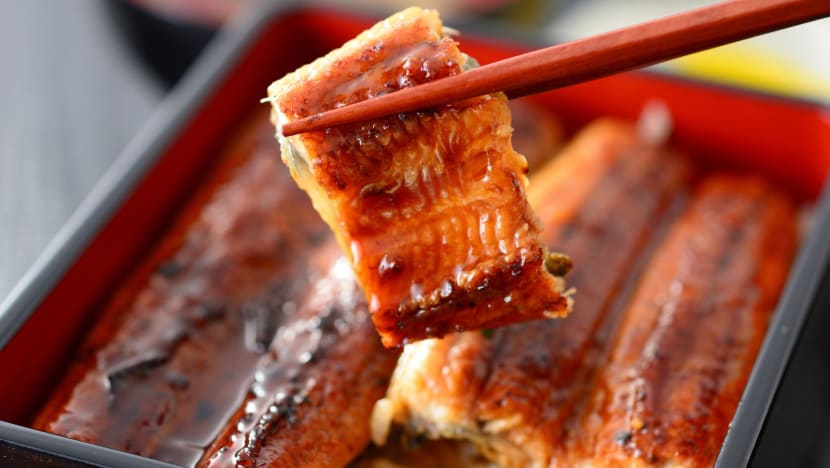Commentary: Seafood mislabelling keeps diners in murky waters
Virtually all unagi sold in Singapore consists of endangered freshwater eels. Many other seafood dishes have less than savoury origins, says researcher Joshua Choo.

File photo of unagi, or Japanese grilled eel. (Photo: iStock/KPS)

This audio is generated by an AI tool.
SINGAPORE: When I explain my research on the conservation status of the grilled eels Singaporeans eat, people are confused. “Why would this matter?” or “Eels can’t be endangered, right?”
Before I learned about the lucrative illegal eel smuggling industry and the various environmental threats eels face, that was also my response.
But, as my recently-published study showed, virtually all of the unagi sold in Singapore consists of endangered freshwater eels (anguillids) – likely moving the American eel toward critical endangerment.
Beyond unagi, many other seafood dishes in Singapore have less than savoury environmental impacts. WWF Singapore highlighted in 2021 that 75 per cent of the seafood species consumed in Singapore are unsustainable, with 120,000 tonnes of seafood eaten per year.
The problem of eel thus speaks to wider issues we face as consumers of seafood.
WE DON’T KNOW WHAT WE’RE EATING
When we eat seafood in Singapore, we often don’t know what we’re eating and how it’s produced. Singapore imports over 90 per cent of the food we consume, and in 2024, 6 per cent of consumed seafood came from local farms.
Many things make identifying seafood difficult. Even when we can see what the animal is, like at wet markets or supermarkets’ whole fish sections, they can still be difficult to tell apart visually. It’s easy to tell if a whole, live eel is an anguillid rather than a moray, but less easy to visually differentiate certain anguillid species.
Seafood also can reach us far removed from how it once looked. For instance, unagi mostly arrives as fillets that are seasoned and grilled, eliminating all the features you’d use to figure out what species you’re eating – like colour, fin shape or body shape.
This issue plagues not only eels. It can be hard to realise we’re threatening vulnerable shark species like hammerheads when purchasing dried shark fin, or endangered whiprays when eating grilled sambal stingray. The same is true of heavily processed products like fish- or shrimp balls, which sometimes contain pork or lack the crustaceans they are named for.
Furthermore, ambiguous labelling is part of the issue. Vague general names like “eel”, “stingray” or “shrimp” can obfuscate the species we’re consuming. Less valuable seafood can be upsold under the guise of more premium products. For instance, fish roe could be sold as prawn roe, and farmed salmon sold as wild-caught salmon.
Besides not knowing what’s in our seafood dishes, we also do not know what journeys they took to reach our plates. When asked where eel products came from, most sellers told me the eels were “farmed in Taiwan”. However, given the fact that eels can’t be bred at industrial scales, the eels grown to saleable size in East Asian farms are always wild-caught and likely from illegal or unregulated fisheries.
The many steps involved in fishery supply chains can hide unsustainable practices like destructive bottom trawling (silver pomfret), overfishing (many regional groupers), and even slave-like conditions on fishing boats (Thai prawn and squid).
LEARN TO BE CURIOUS
One thing we can do as consumers is to be curious. When we eat seafood, we can ask “What am I eating?”, “Where is it from?”, and “How is the animal fished?”
Labels from organisations like the Aquaculture Stewardship Council (ASC) and Marine Stewardship Council (MSC) help identify products that are more sustainable. One can also turn to resources like the WWF Singapore Seafood Guide, or news articles and scientific papers on commonly eaten seafood.
Unfortunately, there is only so much individual consumer choice can do when labels are vague or misleading – which is where regulations and science can help.
For instance, Taiwanese scientists who studied tuna mislabelling highlighted that it is common practice in the European Union to label seafood with scientific names. It’s necessary to create standardised lists of seafood products’ scientific names alongside approved common names and widely used vernacular names according to the “one species-one name” principle.
Researchers and government or international regulatory bodies can use molecular biology to accurately identify seafood, but forensics techniques have their limits. Deep-fried or extensively heat-damaged samples are not easy to analyse, and some fish populations including anguillid eels interbreed so internationally that it’s difficult to split them up by geographical range based on their DNA.
It’s therefore important to lobby for larger-scale changes to seafood markets, through supporting more sustainable food production and demanding more supply chain transparency including better labelling.
Returning to anguillid eels, conversations about eel trafficking by the media and scientists went a long way toward making the eels’ plight visible to unagi-eaters. Having faced my research findings and those of other eel researchers, I’ve stopped eating unagi and encourage others to stop or reduce their unagi consumption.
As our seas face the triple threat of unsustainable resource use, the climate crisis and ocean acidification, it will be important for us to talk about the animals that seem ugly or not worth our time, and to fight against the current for change.
Joshua Choo is a researcher and recent graduate of Yale-NUS College with a Bachelor of Science (with Honors) in Environmental Studies.


















